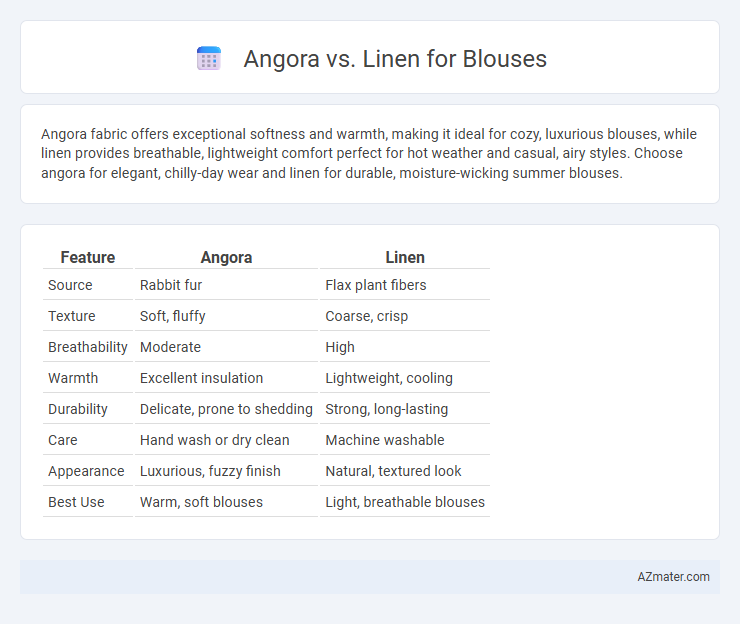Angora fabric offers exceptional softness and warmth, making it ideal for cozy, luxurious blouses, while linen provides breathable, lightweight comfort perfect for hot weather and casual, airy styles. Choose angora for elegant, chilly-day wear and linen for durable, moisture-wicking summer blouses.
Table of Comparison
| Feature | Angora | Linen |
|---|---|---|
| Source | Rabbit fur | Flax plant fibers |
| Texture | Soft, fluffy | Coarse, crisp |
| Breathability | Moderate | High |
| Warmth | Excellent insulation | Lightweight, cooling |
| Durability | Delicate, prone to shedding | Strong, long-lasting |
| Care | Hand wash or dry clean | Machine washable |
| Appearance | Luxurious, fuzzy finish | Natural, textured look |
| Best Use | Warm, soft blouses | Light, breathable blouses |
Introduction to Angora and Linen Fabrics
Angora fabric, derived from the soft undercoat of Angora rabbits, offers exceptional warmth and a silky texture, making it ideal for luxurious blouses. Linen, made from flax fibers, is renowned for its breathability and natural moisture-wicking properties, providing lightweight comfort suitable for warm-weather wear. Both fabrics showcase distinct qualities: Angora emphasizes warmth and softness, while linen highlights durability and cooling effects.
Key Characteristics of Angora
Angora fabric is renowned for its exceptional softness, warmth, and lightweight nature, making it an ideal choice for blouses worn in cooler climates. This natural fiber, derived from the Angora rabbit, offers excellent insulation while maintaining breathability and a luxurious texture that distinguishes it from linen. Unlike linen, which is crisp and highly absorbent, Angora excels in providing a gentle, fuzzy surface that enhances comfort and adds a sophisticated tactile dimension to wearable fashion.
Key Characteristics of Linen
Linen fabric, derived from flax fibers, is celebrated for its exceptional breathability and moisture-wicking properties, making it ideal for blouses in warm climates. Its natural texture offers durability and a subtle sheen, while linen's lightweight and hypoallergenic nature provide comfort and ease of wear. Compared to Angora, linen is less insulating but far more breathable, ensuring a cool, fresh feel throughout the day.
Comfort and Breathability Comparison
Angora fabric offers superior softness and warmth, making it ideal for cooler climates but less breathable for hot weather. Linen excels in breathability and moisture-wicking properties, ensuring comfort during warm seasons while providing a crisp, lightweight feel. Choosing between Angora and Linen for a blouse depends on the desired balance between insulation and ventilation.
Durability and Longevity
Angora fibers, derived from Angora rabbits, offer exceptional softness but tend to be less durable and more prone to pilling compared to linen. Linen, made from flax fibers, is renowned for its high tensile strength and resilience, making it ideal for blouses that require long-lasting wear and frequent washing. Choosing linen ensures greater longevity and durability in blouses, especially for everyday use, while Angora suits delicate, occasional wear garments due to its luxurious texture.
Maintenance and Care Tips
Angora blouses require gentle hand washing with cool water and mild detergent to maintain softness and prevent fiber damage, while avoiding excessive friction or wringing to reduce pilling. Linen blouses are more durable and can be machine washed on a gentle cycle with mild detergent, but require prompt air drying to prevent mildew and avoid high heat to maintain fabric integrity. Both fabrics benefit from storing in breathable garment bags and avoiding direct sunlight to preserve color and texture longevity.
Style and Aesthetic Appeal
Angora offers a luxurious, soft texture with a delicate halo effect, creating an elegant, cozy aesthetic perfect for sophisticated blouses. Linen presents a crisp, breathable fabric with a natural, textured look that enhances a relaxed, effortless style ideal for warm-weather blouses. Both fabrics excel in different style contexts: Angora emphasizes refined softness, while Linen highlights clean lines and casual elegance.
Suitable Seasons and Occasions
Angora blouses are ideal for colder seasons such as fall and winter, offering warmth and a soft texture suitable for formal events or cozy gatherings. Linen blouses excel in spring and summer due to their lightweight, breathable fabric, perfect for casual outings, beachwear, or daytime events. Choosing between Angora and Linen depends on the desired comfort level, insulation needs, and occasion, with Angora providing insulation and elegance, while Linen ensures breathability and relaxed style.
Sustainability and Ethical Considerations
Angora, sourced from Angora rabbits, offers a soft and warm fabric but raises ethical concerns due to animal welfare issues linked to fur harvesting practices. Linen, derived from flax plants, stands out for its eco-friendly production, requiring fewer pesticides and less water, fostering sustainable agriculture and biodegradable fabric benefits. Prioritizing linen for blouses supports ethical fashion through cruelty-free materials and lower environmental impact, aligning with sustainable clothing goals.
Choosing the Right Fabric for Your Blouse
Angora offers a soft, warm texture ideal for cooler weather blouses, providing comfort and a luxurious feel, while linen is breathable and lightweight, perfect for hot climates and casual, airy styles. Choosing the right fabric depends on your climate and style preferences; opt for Angora if you want insulation and softness, whereas linen suits those seeking moisture-wicking and a crisp, natural look. Consider durability and care requirements--Angora requires gentle handling, while linen is easier to maintain and becomes softer with each wash.

Infographic: Angora vs Linen for Blouse
 azmater.com
azmater.com